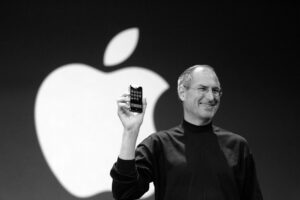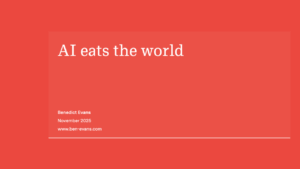
“Innovation starts with understanding who people are becoming, because in there are the insights into how they shop and why.” – Brian Solis, principal analyst at Altimeter Group
Not too long ago, I had the opportunity to present my vision for retail innovation and shopper experience at “The Summit” hosted by AT&T in Dallas. Following the event, the AT&T Editorial Team, published a written summary and also a video highlight reel of my talk. I wanted to share them with you here.
I hope this help you!
Retail gets a digital revamp
Evolving customer behavior is leading the way for retail companies
Solis — a futurist and analyst — stood before a room of the country’s top retail leaders at The AT&T Business Summit. He polled the crowd, asking them what’s holding them back from driving meaningful innovation at their own organizations. The top response? Getting a handle on consumers’ rapidly changing behaviors.
According to Solis, these responders have already done at least one thing right: they’ve identified the most important challenge.
At the heart of retail innovation is re-calibrating consumers’ expectations. And with each smoother transaction and moment of delight is a shopper that expects and demands more. Consumer behavior is evolving by the day, and here are four of-the-moment shifts that are shaping (and challenging) the way traditional retailers do business.
1. “Instagrammable” is a word
One of the most viral retail experiences of today is New York and San Francisco’s Museum of Ice Cream – a vivid, fantasyland “museum” dreamt up by a woman dubbed “The Millennial Walt Disney.” The museum experience hinges on visitors’ compulsion to take dozens of photos of their visit and share them online — in short, it’s “Instagrammable.”
“These [experiences] were designed to cater to the new minds of the connected consumer because they all need new backdrops for Instagram,” Solis says.
With a modern consumer whose cultural relevancy is maintained through the scrolls of Snapchat, Facebook and Instagram, retail experiences that reign supreme are those designed to be shared. While most retailers don’t have a reason to build a swimming pool full of rainbow-colored sprinkles, all are being challenged to create encounters that translate beautifully and seamlessly to smartphone screens.

2. “Mobile first” becomes “mobile only”
“Mobile first” has been adopted as a design principle industry-wide.
The idea: design first and foremost with mobile experiences in mind, then — and only then — design for tablet, laptop and desktop digital experiences. But for more and more consumers, the smartphone isn’t just their primary device — it’s their only device. The lesson here is to keep these shoppers top of mind.
If they only ever encounter your brand’s touchpoints on their mobile device, are they getting the best of your brand? The industry can no longer expect shoppers to walk in the doors of their brick-and-mortar location — even though it was once seen as the holy grail of a consumer’s retail experience.
“Mobile has been the biggest disrupter in business, in retail, in life, in everything,” Solis says, “And most investments are looking at ‘How does that change your expectations?’”
3. We trust the robots
Humans have been historically hesitant to trust robots with much — chalk it up to too many sci-fi movies. But the reality is, shoppers are using what could be argued as “artificial intelligence” every day.
Think Siri, Cortana, Google Assistant, Alexa, even the chat bots that field our online customer service inquiries. And consumers aren’t just asking for the weather report; they’re maintaining shopping lists, tracking packages, even initiating transactions.
It’s key to remember that retail begins long before customers enter the door, and can begin with a phrase as simple as “Alexa, can you…?” Robots and artificial intelligence will only get more sophisticated and become more integrated into our daily shopping experiences.
“Customers, once they taste a new experience that means something, they do not go backwards,” Solis says.
4. Friction is a deal breaker
As Uber quickly became urbanites’ de facto mode of on-demand car service, consumers discovered a new standard of what they could — and would — expect. Conventional taxis have since become nearly obsolete and society shows no signs of turning back. Through services like Uber, Tinder, Venmo and Amazon’s new “Amazon Go” store, consumers are being trained to reject digital experiences that aren’t effortless.
“I call today’s customer ‘accidental narcissists’ because all these products and services are teaching us that we can have what we want, when we want, how we want,” Solis says. “This is the standard.”
As retail transactions increasingly migrate from brick and mortar to online, mobile and curbside, organizations are challenged to reinvent the consumer experience — not simply reconfigure it.
Brian also released his latest research report that explores leading innovation trends in retail. You can download it, at no cost, here.
Please Watch the Highlight Video!
Brian Solis
Brian Solis is principal analyst and futurist at Altimeter, the digital analyst group at Prophet, Brian is world renowned keynote speaker and 7x best-selling author. His latest book, X: Where Business Meets Design, explores the future of brand and customer engagement through experience design.
Please, invite him to speak at your event or bring him in to inspire and change executive mindsets.
Connect with Brian!
Twitter: @briansolis
Facebook: TheBrianSolis
LinkedIn: BrianSolis
Instagram: BrianSolis
Youtube: BrianSolisTV
Newsletter: Subscribe
RSS: Subscribe





As always a great summary of what is going on. Especially friction is offering so many new opportunities (and new players) – just by taking the hassle from peoples lives. And there is much to do ;). Thanks for keeping us inspired.
Thank you Ricardo.